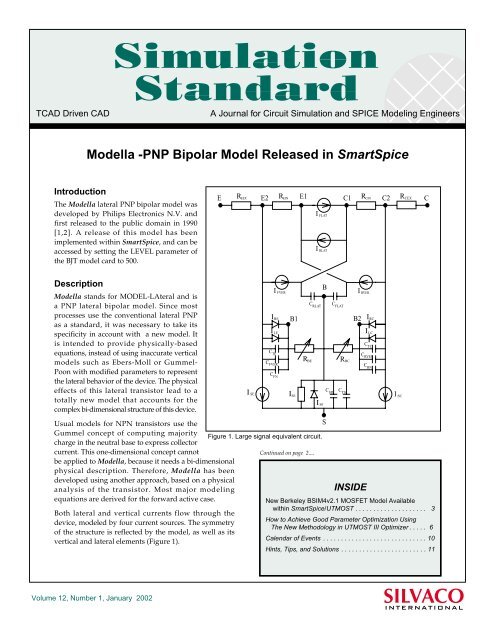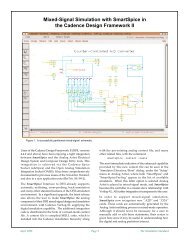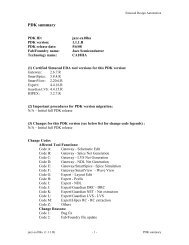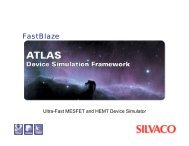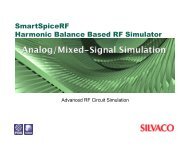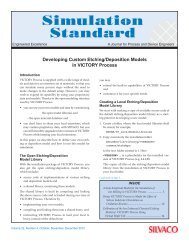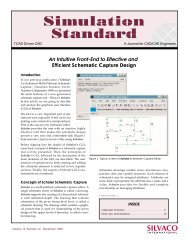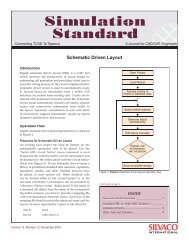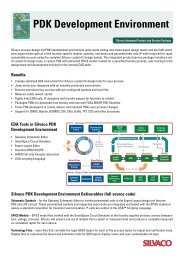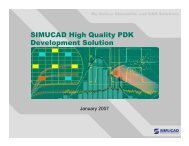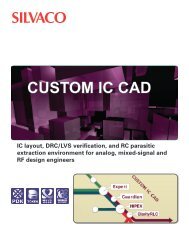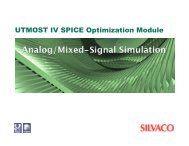Modella -PNP Bipolar Model Released in SmartSpice - Silvaco
Modella -PNP Bipolar Model Released in SmartSpice - Silvaco
Modella -PNP Bipolar Model Released in SmartSpice - Silvaco
You also want an ePaper? Increase the reach of your titles
YUMPU automatically turns print PDFs into web optimized ePapers that Google loves.
TCAD Driven CAD A Journal for Circuit Simulation and SPICE <strong>Model</strong><strong>in</strong>g Eng<strong>in</strong>eers<br />
Introduction<br />
<strong><strong>Model</strong>la</strong> -<strong>PNP</strong> <strong>Bipolar</strong> <strong>Model</strong> <strong>Released</strong> <strong>in</strong> <strong>SmartSpice</strong><br />
The <strong><strong>Model</strong>la</strong> lateral <strong>PNP</strong> bipolar model was<br />
developed by Philips Electronics N.V. and<br />
first released to the public doma<strong>in</strong> <strong>in</strong> 1990<br />
[1,2]. A release of this model has been<br />
implemented with<strong>in</strong> <strong>SmartSpice</strong>, and can be<br />
accessed by sett<strong>in</strong>g the LEVEL parameter of<br />
the BJT model card to 500.<br />
Description<br />
<strong><strong>Model</strong>la</strong> stands for MODEL-LAteral and is<br />
a <strong>PNP</strong> lateral bipolar model. S<strong>in</strong>ce most<br />
processes use the conventional lateral <strong>PNP</strong><br />
as a standard, it was necessary to take its<br />
specificity <strong>in</strong> account with a new model. It<br />
is <strong>in</strong>tended to provide physically-based<br />
equations, <strong>in</strong>stead of us<strong>in</strong>g <strong>in</strong>accurate vertical<br />
models such as Ebers-Moll or Gummel-<br />
Poon with modified parameters to represent<br />
the lateral behavior of the device. The physical<br />
effects of this lateral transistor lead to a<br />
totally new model that accounts for the<br />
complex bi-dimensional structure of this device.<br />
Usual models for NPN transistors use the<br />
Gummel concept of comput<strong>in</strong>g majority<br />
charge <strong>in</strong> the neutral base to express collector<br />
current. This one-dimensional concept cannot<br />
be applied to <strong><strong>Model</strong>la</strong>, because it needs a bi-dimensional<br />
physical description. Therefore, <strong><strong>Model</strong>la</strong> has been<br />
developed us<strong>in</strong>g another approach, based on a physical<br />
analysis of the transistor. Most major model<strong>in</strong>g<br />
equations are derived for the forward active case.<br />
Both lateral and vertical currents flow through the<br />
device, modeled by four current sources. The symmetry<br />
of the structure is reflected by the model, as well as its<br />
vertical and lateral elements (Figure 1).<br />
Volume 12, Number 1, January 2002<br />
E<br />
REEX E2 REIN E1<br />
C1 RCIN C2 RCEX C<br />
I SE<br />
I FVER<br />
IRE<br />
I LE<br />
CTE<br />
CFVER<br />
CFN<br />
ISE<br />
R BE<br />
Cont<strong>in</strong>ued on page 2....<br />
I FLAT<br />
I RLAT<br />
I SF<br />
Figure 1. Large signal equivalent circuit.<br />
B<br />
CRLAT CFLAT<br />
B1 B2<br />
S<br />
RBC<br />
CSD CTS<br />
I RVER<br />
INSIDE<br />
IRC<br />
I LC<br />
CTC<br />
CRVER<br />
CRN<br />
New Berkeley BSIM4v2.1 MOSFET <strong>Model</strong> Available<br />
with<strong>in</strong> <strong>SmartSpice</strong>/UTMOST . . . . . . . . . . . . . . . . . . . . 3<br />
How to Achieve Good Parameter Optimization Us<strong>in</strong>g<br />
The New Methodology <strong>in</strong> UTMOST III Optimizer . . . . . 6<br />
Calendar of Events . . . . . . . . . . . . . . . . . . . . . . . . . . . . . 10<br />
H<strong>in</strong>ts, Tips, and Solutions . . . . . . . . . . . . . . . . . . . . . . . . 11<br />
I SC<br />
SILVACO<br />
INTERNATIONAL
Figure 2. Forward IC vs Vce characteristics.<br />
<strong>Model</strong>ed effects are :<br />
● Temperature (without self-heat<strong>in</strong>g)<br />
● Charge storage<br />
● Excess phase shift for current and storage charges<br />
● High-<strong>in</strong>jection<br />
● Built-<strong>in</strong> electric field <strong>in</strong> base region<br />
● Bias-dependent Early effect<br />
● Low-level non-ideal base currents<br />
● Hard and quasi-saturation<br />
● Weak avalanche<br />
● Current crowd<strong>in</strong>g (DC, AC and<br />
transient) and conductivity modulation<br />
for base resistance<br />
● Hot carrier effects <strong>in</strong> the collector epilayer<br />
● Explicit model<strong>in</strong>g of <strong>in</strong>active regions<br />
● Split base-collector depletion capacitance<br />
Validation<br />
In order to validate <strong>SmartSpice</strong> results,<br />
values were compared with Philips own<br />
<strong>in</strong>-house simulator output. PStar was used<br />
with test circuits for operat<strong>in</strong>g po<strong>in</strong>t, DC<br />
and AC analysis. Outputs for DC simulations<br />
match between PStar and <strong>SmartSpice</strong>.<br />
References<br />
Examples<br />
<strong><strong>Model</strong>la</strong> is more complex than Gummel-<br />
Poon models, because it is composed of<br />
as much as 6 <strong>in</strong>ternal nodes. However<br />
its symmetry and the nature of the equations<br />
used lead to convergence with the same<br />
performance as other models do.<br />
Typical characteristics for the <strong><strong>Model</strong>la</strong><br />
device are presented <strong>in</strong> Figure 2.<br />
<strong><strong>Model</strong>la</strong> also accounts for advanced<br />
effects, such as excess phase.<br />
The basic Gummel-Poon model is a<br />
one-pole model, but <strong>in</strong> fact a bipolar<br />
device has two poles. This results <strong>in</strong><br />
simulation errors, estimat<strong>in</strong>g cutoff<br />
frequency and ga<strong>in</strong> too high and also<br />
predict<strong>in</strong>g smaller phase shift. The<br />
EXPHI parameter of the <strong><strong>Model</strong>la</strong> model<br />
allows the designer to add the second<br />
pole phase contribution, expressed <strong>in</strong><br />
radians. Figure 3 presents the small-signal<br />
ga<strong>in</strong> hFE for an <strong>in</strong>verter circuit us<strong>in</strong>g one<br />
<strong><strong>Model</strong>la</strong> device.<br />
[1] ‘Nat. lab Unclassified Report No. 2001/804, Physically<br />
based compact model<strong>in</strong>g of lateral <strong>PNP</strong> transistors.’ F.G.<br />
O’Hara B.E.<br />
[2] ‘Nat. lab Unclassified Report No. 6131, A new physical<br />
compact model for lateral <strong>PNP</strong> transistors’, F.G. O’Hara,<br />
J.J.H. van den Biesen, H.C. de Graaff and J.B. Foley.<br />
Figure 3. Forward current ga<strong>in</strong> vs. frequency and excess-phase<br />
The Simulation Standard Page 2 January 2002
New Berkeley BSIM4v2.1 MOSFET <strong>Model</strong> Available With<strong>in</strong><br />
<strong>SmartSpice</strong>/UTMOST III<br />
1. Introduction<br />
So far the BSIM3v3.2 MOSFET model, developed by<br />
UC-Berkeley, has been considered as the <strong>in</strong>dustry<br />
standard model for deep-submicron CMOS design. It<br />
was rapidly adopted by IC companies and foundries<br />
for model<strong>in</strong>g devices down to 0.25 . However, for<br />
device scale down to 0.10 , some physical mechanisms<br />
need to be better characterized.<br />
BSIM4 model is developed to explicitly address the<br />
follow<strong>in</strong>g issues, for which BSIM3v3 was found lack<strong>in</strong>g<br />
and <strong>in</strong>accurate:<br />
● <strong>Model</strong><strong>in</strong>g of sub-0.13 microns MOSFET devices<br />
● High-frequency analog and high-speed digital<br />
CMOS circuit simulation<br />
● Layout-dependent parasitics model<br />
UC-Berkeley officially released BSIM4v0.0 for the first<br />
time on March 24, 2000. Later versions BSIM4v1.0,<br />
BSIM4v2.0 and BSIM4v2.1 were released on October 11,<br />
2000, on April, 06 2001 and on October 05, 2001,<br />
respectively. They account for user’s feedback and<br />
provide bug fixes over earlier versions.<br />
This article is <strong>in</strong>tended to give an overview of the<br />
implementation of BSIM4 with<strong>in</strong> <strong>Silvaco</strong> products.<br />
Further details and up-to-date <strong>in</strong>formation may be<br />
found <strong>in</strong> <strong>SmartSpice</strong>/UTMOST <strong>Model</strong><strong>in</strong>g Manuals and<br />
<strong>SmartSpice</strong> Release Notes.<br />
Readers <strong>in</strong>terested <strong>in</strong> obta<strong>in</strong><strong>in</strong>g more detail about<br />
BSIM4 may refer to the Berkeley documentation and<br />
source code, available for download at:<br />
http://www-device.eecs.berkeley.edu/~bsim3/bsim4.html<br />
2. Fundamental Improvements Over<br />
BSIM3v3.2<br />
Like BSIM3v3.2, BSIM4 accounts for major physical effects:<br />
● Short/Narrow channel effects on threshold voltage<br />
● Non-uniform dop<strong>in</strong>g effects<br />
● Mobility reduction due to vertical field<br />
● Bulk charge effect<br />
● Carrier velocity saturation<br />
● Dra<strong>in</strong> <strong>in</strong>duced barrier lower<strong>in</strong>g (DIBL)<br />
● Channel length modulation (CLM)<br />
● Source/Dra<strong>in</strong> parasitic resistances<br />
● Substrate current <strong>in</strong>duced body effect (SCBE)<br />
● Quantum mechanic charge thickness model<br />
● Unified flicker noise model<br />
Figure 1. BSIM4 DC characteristics.<br />
BSIM4 has the follow<strong>in</strong>g major improvements and<br />
additions over BSIM3v3.2:<br />
● an accurate new model of the <strong>in</strong>tr<strong>in</strong>sic <strong>in</strong>put resistance<br />
for both RF, high-frequency analog and high-speed<br />
digital applications<br />
● flexible substrate resistance network for RF model<strong>in</strong>g<br />
● a new accurate channel thermal noise model and a<br />
noise partition model for the <strong>in</strong>duced gate noise<br />
● a non-quasi-static (NQS) model that is consistent<br />
with the Rg-based RF model and a consistent AC<br />
model that accounts for the NQS effect <strong>in</strong> both<br />
transconductances and capacitances<br />
● an accurate gate direct tunnel<strong>in</strong>g model<br />
● a comprehensive and versatile geometry-dependent<br />
parasitics model for various source/dra<strong>in</strong><br />
connections and multi-f<strong>in</strong>ger devices<br />
● improved model for steep vertical retrograde<br />
dop<strong>in</strong>g profiles<br />
● better model for pocket-implanted devices <strong>in</strong> Vth,<br />
bulk charge effect model, and Rout<br />
● asymmetrical and bias-dependent source/dra<strong>in</strong><br />
resistance, either <strong>in</strong>ternal or external to the <strong>in</strong>tr<strong>in</strong>sic<br />
MOSFET at the user’s discretion<br />
● acceptance of either the electrical or physical gate<br />
oxide thickness as the model <strong>in</strong>put at the user’s<br />
choice <strong>in</strong> a physically accurate manner<br />
● the quantum mechanical charge-layer-thickness<br />
model for both IV and CV<br />
● a more accurate mobility model for predictive model<strong>in</strong>g<br />
January 2002 Page 3 The Simulation Standard
Figure 2. BSIM4 RF/High-Speed model: digital r<strong>in</strong>g oscillator.<br />
● a gate-<strong>in</strong>duced dra<strong>in</strong> leakage (GIDL) current model,<br />
available <strong>in</strong> BSIM for the first time<br />
● an improved unified flicker (1/f) noise model, which<br />
is smooth over all bias regions and considers the bulk<br />
charge effect<br />
● different diode IV and CV characteristics for source<br />
and dra<strong>in</strong> junctions<br />
● junction diode breakdown with or without current<br />
limit<strong>in</strong>g<br />
● dielectric constant of the gate dielectric as a model<br />
parameter<br />
3. <strong>Silvaco</strong> Implementation<br />
The <strong>Silvaco</strong> implementation of BSIM4 is based on the<br />
official Berkeley releases. BSIM4 is currently accessible<br />
with<strong>in</strong> <strong>SmartSpice</strong>/UTMOST by specify<strong>in</strong>g the model<br />
selector LEVEL=14. The alias LEVEL=54 is also<br />
supported for HSpice compatibility.<br />
The most recent version (BSIM4v2.1) is selected by<br />
default but older versions may be <strong>in</strong>voked by specify<strong>in</strong>g<br />
the model parameter VERSION=0.0, 1.0 or 2.0. In the<br />
<strong>Silvaco</strong> implementation, VERSION is a real value and<br />
not a str<strong>in</strong>g, as <strong>in</strong> the Berkeley code. Consequently, the<br />
Berkeley syntax VERSION=4.2.1 corresponds to<br />
VERSION=2.1 <strong>in</strong> <strong>SmartSpice</strong>/UTMOST III. A warn<strong>in</strong>g<br />
message is issued when an <strong>in</strong>valid VERSION number is<br />
given. It is recommended to systematically use the most<br />
recent version to benefit from the last Berkeley bug fixes<br />
and improvements.<br />
The structure of the orig<strong>in</strong>al Berkeley code has been<br />
modified. These changes do not directly <strong>in</strong>volve equations,<br />
except m<strong>in</strong>or bug fixes <strong>in</strong> derivatives. So they do not<br />
affect the accuracy of results but may significantly<br />
improve convergence. The <strong>Silvaco</strong> implementation<br />
offers the best performances regard<strong>in</strong>g speed and<br />
convergence without any loss of accuracy.<br />
3.1 Differences Between BSIM4v2.1 and BSIM4v2.0<br />
BSIM4v2.1 provides bug fixes over its previous version,<br />
BSIM4v2.0. Most of them were already <strong>in</strong>cluded <strong>in</strong> the<br />
<strong>Silvaco</strong> implementation of BSIM4v2.0 when UC-Berkeley<br />
released the new version. Consequently, only the<br />
changes listed below have been <strong>in</strong>corporated. They are<br />
active only if VERSION=2.1 is selected:<br />
● Gate Induced Source Leakage (GISL) is added to give an<br />
enormous improvement <strong>in</strong> simulation convergence.<br />
Together with GIDL, it makes the gate <strong>in</strong>duced leakage<br />
component of the substrate current symmetric<br />
● The warn<strong>in</strong>g limits for effective channel length,<br />
channel width and gate oxide thickness (Leff,<br />
LeffCV, Weff, WeffCV, Toxe, Toxp and Toxm) are<br />
substantially decreased to avoid a large number of<br />
warn<strong>in</strong>gs when BSIM4 is used beyond its design<br />
region. For mean<strong>in</strong>gful results, it is still recommended<br />
to keep these variables/ parameters with<strong>in</strong> the<br />
BSIM4 design region. This change is <strong>in</strong>tended only to<br />
allow users to extend the model beyond this region<br />
with fewer warn<strong>in</strong>gs.<br />
● The model parameter ACDE is now checked only<br />
when CAPMOD=3 to avoid useless warn<strong>in</strong>g messages<br />
● The 1/f noise bug fix avoids negative DelClm when<br />
calculat<strong>in</strong>g noise density by turn<strong>in</strong>g off the second<br />
part of the noise density equation<br />
● In addition, this version adds many variables as output<br />
such as some of the current components (igs, igd, igb,<br />
igcs, igcd, isub, igidl, igisl) to ease the model verifications<br />
3.2 Differences Between BSIM4v2.0 and BSIM4v1.0<br />
The improvements <strong>in</strong>corporated <strong>in</strong>to BSIM4v2.0 are<br />
bug fixes and two new model parameters XL and XW.<br />
XL and XW are geometry offset parameters due to<br />
mask/etch effect with default values of 0.0. With these<br />
changes, the BSIM3 parasitic resistance model file<br />
becomes a compatible subset of the BSIM4 parasitic<br />
resistance model.<br />
In versions 0.0 and 1.0, the value of the <strong>in</strong>tr<strong>in</strong>sic capacitance<br />
cbdb of the CAPMOD=0 capacitance model was wrong.<br />
This has been corrected <strong>in</strong> version 2.0.<br />
Also, the computation efficiency is enhanced due to a<br />
better extraneous node allocation strategy. In version<br />
2.0, <strong>in</strong>ternal dra<strong>in</strong> and source nodes are created only if<br />
access resistances have non-zero values or if a noise<br />
analysis is performed with the holistic thermal noise<br />
model selected (TNOIMOD=1). When extraneous nodes<br />
collapse, the size of the matrix is reduced, lead<strong>in</strong>g to a<br />
significant ga<strong>in</strong> of speed, especially with large circuits.<br />
January 2002 Page 4 The Simulation Standard
3.3 Differences between BSIM4v1.0 and BSIM4v0.0<br />
The improvements of BSIM4.1.0 over BSIM4.0.0 are bug<br />
fixes and an analytical equation for the model parameter<br />
PIGCD when it is not specified. The relevant changes are:<br />
● Gate Tunnel<strong>in</strong>g Currents: <strong>in</strong> BSIM4.0.0, PIGCD is set<br />
to a constant value (1.0) if unspecified. In BSIM4.1.0,<br />
its default value is given by an analytical equation:<br />
B ⋅ TOXE<br />
PIGCD = ----------------------- ⋅ ⎛1– ---------------------- ⎞<br />
2 ⎝ 2 ⋅ V ⎠<br />
gsteff<br />
V gsteff<br />
V dseff<br />
where B is a constant, set to 7.45669e11 for NMOS or<br />
to 1.16645e12 for PMOS, and TOXE is a model parameter<br />
(Electrical gate equivalent oxide thickness).<br />
● Thermal Noise Charge Based <strong>Model</strong> (TNOIMOD=0):<br />
<strong>in</strong> BSIM4.0.0, the <strong>in</strong>version charge Q<strong>in</strong>v used <strong>in</strong> the<br />
thermal noise current formulation depends on the<br />
effective saturation voltage calculated for the dra<strong>in</strong><br />
current equation, which causes a current spike. In<br />
BSIM4.1.0, this bug has been fixed by replac<strong>in</strong>g the<br />
orig<strong>in</strong>al value of Vdsat by a simple expression,<br />
correspond<strong>in</strong>g to a long-channel saturation voltage:<br />
V dsat<br />
V gsteff<br />
= ---------------<br />
Abulk ● Parameter check<strong>in</strong>g: <strong>in</strong> BSIM4.0.0, the maximum<br />
number of device f<strong>in</strong>gers (NF) is limited to 500. In<br />
BSIM4.1.0, this limit is removed and if NF is too large<br />
and makes the effective width (Weff) to be lower<br />
than or equal to zero, a fatal error will be issued.<br />
3.4 <strong>Silvaco</strong> Specific Features<br />
The follow<strong>in</strong>g <strong>SmartSpice</strong>-specific features have been<br />
added to the orig<strong>in</strong>al Berkeley implementation, for all<br />
BSIM4 versions:<br />
● The BSIM4 code has been optimized to benefit from<br />
<strong>SmartSpice</strong> multi-thread<strong>in</strong>g capabilities. A ga<strong>in</strong> of<br />
speed of 30% or more may be observed on 2-processors<br />
mach<strong>in</strong>es, especially when runn<strong>in</strong>g large circuits<br />
● The VZERO and BYPASS options are fully supported.<br />
Specify<strong>in</strong>g VZERO=2 and/or BYPASS=1 on<br />
.OPTION l<strong>in</strong>es may significantly speed-up computation<br />
for transient analysis. The orig<strong>in</strong>al Berkeley BYPASS<br />
criterion has been modified to ensure accuracy and<br />
for HSpice compatibility<br />
● The <strong>SmartSpice</strong> standard multiplier, useful to put<br />
several identical transistors <strong>in</strong> parallel, is supported<br />
as a BSIM4 <strong>in</strong>stance parameter M. This parameter is<br />
not equivalent to the <strong>in</strong>stance parameter NF (number<br />
of f<strong>in</strong>gers) <strong>in</strong>troduced <strong>in</strong> BSIM4 by Berkeley to<br />
account for devices <strong>in</strong> parallel. Please refer to<br />
Berkeley documentation for further details on this<br />
new parameter<br />
● In <strong>SmartSpice</strong>, it is possible to specify the temperature<br />
of each device us<strong>in</strong>g the standard <strong>in</strong>stance parameters<br />
TEMP and DTEMP. They are also supported for<br />
BSIM4 <strong>in</strong>stances. TEMP has the highest priority and<br />
correspond to the temperature of the device <strong>in</strong>. If TEMP<br />
is unspecified and DTEMP is specified, the <strong>in</strong>stance<br />
temperature is evaluated by add<strong>in</strong>g DTEMP to the<br />
circuit temperature. If none of these parameters are<br />
specified the circuit temperature is used, which defaults<br />
to 27 if unspecified with .OPTION or .TEMP statements<br />
● The orig<strong>in</strong>al Berkeley BSIM4 parameter check<strong>in</strong>g<br />
scheme has been modified to avoid the same warn<strong>in</strong>g<br />
message be issued several times when a parameter is<br />
out of range. In the <strong>Silvaco</strong> implementation, <strong>in</strong>stance<br />
and model parameters are separately tested. As the<br />
ma<strong>in</strong> consequence, each warn<strong>in</strong>g message is now<br />
issued only once<br />
● The implementation of NQS models has been<br />
optimized so that related matrix elements are created<br />
only when TRNQSMOD or ACNQSMOD selector<br />
are set to 1. That fixes a s<strong>in</strong>gular matrix error when<br />
TRNQSMOD=1 and ACNQSMOD=0<br />
● The <strong>SmartSpice</strong> standard conductances GMIN/<br />
DCGMIN have been added. They are connected <strong>in</strong><br />
parallel with bulk junction diodes and between <strong>in</strong>ternal<br />
dra<strong>in</strong> and source nodes. They account for the <strong>in</strong>stance<br />
multiplier (M) and the number of device f<strong>in</strong>gers (NF)<br />
● The CAPTAB and DCCAP options are supported.<br />
● The term<strong>in</strong>al currents and charges can be pr<strong>in</strong>ted,<br />
plotted or saved for DC, TRAN and AC analysis us<strong>in</strong>g<br />
the <strong>SmartSpice</strong> syntax @<strong>in</strong>stance_name[variable_name].<br />
The related variable names are listed <strong>in</strong> Table 1<br />
Variable name (alias) Def<strong>in</strong>ition<br />
id (cd) Dra<strong>in</strong> term<strong>in</strong>al current<br />
cs Source term<strong>in</strong>al current<br />
cg Gate term<strong>in</strong>al current<br />
cb Bulk term<strong>in</strong>al current<br />
*qdra<strong>in</strong> Intr<strong>in</strong>sic dra<strong>in</strong> charge<br />
*qbulk Intr<strong>in</strong>sic bulk charge<br />
*qgate Intr<strong>in</strong>sic gate charge<br />
*qd Total dra<strong>in</strong> charge<br />
*qb Total bulk charge<br />
*qg Total gate charge<br />
*cqd Total dra<strong>in</strong> capacitance current<br />
*cqb Total bulk capacitance current<br />
*cqg Total gate capacitance current<br />
Table 1. BSIM4 extra output variables added <strong>in</strong> <strong>SmartSpice</strong>.<br />
The variables marked with an asterisk are systematically<br />
computed after transient and small-signal analysis. For<br />
DC analysis, they are computed only if DCCAP option<br />
is turned on.<br />
January 2002 Page 5 The Simulation Standard
How to Achieve Good Parameter Optimization Us<strong>in</strong>g The<br />
New Methodology <strong>in</strong> UTMOST III Optimizer<br />
1.Introduction<br />
What is the goal of optimization?<br />
The optimization is the task of f<strong>in</strong>d<strong>in</strong>g the<br />
absolute best set of admissible conditions to<br />
achieve your objective, formulated <strong>in</strong><br />
mathematical terms. The goal of optimization<br />
is, given a system, to f<strong>in</strong>d the sett<strong>in</strong>g of it’s<br />
parameters so that to obta<strong>in</strong> the optimal<br />
performance. The performance of the system<br />
is given by an evaluation function.<br />
Optimization problems are commonly found<br />
<strong>in</strong> a wide range of fields, and it is also of<br />
central concern to many problems.<br />
The basic approach <strong>in</strong> all cases is usually the<br />
same: User selects or designs a “merit-function”<br />
that measures the agreement between the<br />
data and the model with a particular choice<br />
of parameters. The merit function is generally<br />
designed so that small values represent close<br />
agreement. The parameters and the model<br />
are then adjusted to achieve a m<strong>in</strong>imum <strong>in</strong><br />
the merit function, yield<strong>in</strong>g best-parameters<br />
set. The adjustment process is thus a problem<br />
<strong>in</strong> m<strong>in</strong>imization <strong>in</strong> many dimensions. The<br />
computational wish is always the same: do it<br />
quickly and cheaply. Often the computational effort is<br />
dom<strong>in</strong>ated by the cost of evaluat<strong>in</strong>g the merit function<br />
(and perhaps its partial derivatives). In such cases, the<br />
wishes are sometimes replaced by a simple goal:<br />
Evaluate the merit-function as few times as possible.<br />
F<strong>in</strong>d<strong>in</strong>g a global extremum is, <strong>in</strong> general, a very difficult<br />
problem.<br />
Two standard methods are widely used:<br />
● f<strong>in</strong>d local extrema start<strong>in</strong>g from widely vary<strong>in</strong>g<br />
start<strong>in</strong>g values of the <strong>in</strong>dependent variables and then<br />
pick the most extreme of these<br />
● perturb a local extremum by tak<strong>in</strong>g a f<strong>in</strong>ite amplitude<br />
step away from it, and then see if your method<br />
returns you a better po<strong>in</strong>t, or always to the same one<br />
(Simulated Anneal<strong>in</strong>g)[1]<br />
Unfortunately, there is no perfect optimization algorithm.<br />
and the choice of the optimization method is based on<br />
the follow<strong>in</strong>g consideration: A selection must be made<br />
between methods that need only evaluations of the<br />
“merit-function “to m<strong>in</strong>imize and those that also require<br />
evaluations of the derivatives of that functions.<br />
Algorithms us<strong>in</strong>g the derivative are somewhat more<br />
powerful than those us<strong>in</strong>g only the function, but not<br />
always enough so as to compensate for the additional<br />
calculations of derivatives.<br />
Successive L<strong>in</strong>e<br />
Optimization<br />
(Direction Set)<br />
No Gradient<br />
Computation<br />
Powell s<br />
Method<br />
Conjugate Gradient<br />
Method<br />
Multidimensional Optimization<br />
Gradient<br />
Computation<br />
Quasi Newton<br />
Method<br />
Figure 1. The basic optimization methods.<br />
General<br />
(No direction set)<br />
Downhill Simplex<br />
Levenberg-Marquardt Simulated Anneal<strong>in</strong>g<br />
Figure 1 describes the two different basic optimization<br />
methods. One is based on direction-set, the other not.<br />
The well known Levenberg-Marquardt[2] method is<br />
associated to the direction-set, the Downhill Simplex<br />
method and the Simulated anneal<strong>in</strong>g are issued from<br />
the no-direction set way.<br />
It should take <strong>in</strong>to account that optimization is always a<br />
question of compromise. The ma<strong>in</strong> problem of the<br />
optimization with spice model is that the cost of an<br />
evaluation of the merit-function is very high (i.e. it’s<br />
very long). The Levenberg-Marquardt method<br />
implemented for many years <strong>in</strong> UTMOST optimizer<br />
limit the number of evaluation of the merit-function but<br />
also computes the derivatives. Now available, the<br />
Downhill Simplex method does not not compute the<br />
derivatives. In fact, our goal is to make available<br />
the Simulated Anneal<strong>in</strong>g method <strong>in</strong> which have<br />
demonstrated important successes on a variety of global<br />
optimization problems[3].<br />
Read<strong>in</strong>g the follow<strong>in</strong>g pages you will f<strong>in</strong>d an<br />
explanation of the two optimization methods now<br />
available <strong>in</strong> UTMOST. The goal of explanations is to<br />
give a reader the bases of optimization theory <strong>in</strong> order<br />
to perform better optimizations us<strong>in</strong>g the two methods.<br />
The Simulation Standard Page 6 January 2002
2. The Levenberg-Marquardt Method<br />
2.1 Basic Theory<br />
The Levenberg-Marquardt method is a standard of<br />
non-l<strong>in</strong>ear least-squares optimization rout<strong>in</strong>es[4]<br />
It def<strong>in</strong>es a merit function and determ<strong>in</strong>es the best fit<br />
parameters by it’s m<strong>in</strong>imization. Given a trial values for<br />
the parameters the procedure improves the trial<br />
solution and is repeated until stop decreas<strong>in</strong>g.<br />
Basically the model to be fitted is y = y(x;a) (2.1)<br />
where a is the set of parameters and the χ 2 merit function is:<br />
The basic idea is to take a step down the gradient<br />
(steepest descent method), that we can write as:<br />
Where λ is def<strong>in</strong>ed as a constant (the step).<br />
It is conventional to def<strong>in</strong>e<br />
and<br />
Suppos<strong>in</strong>g that the merit function χ 2 (a) is well<br />
approached by is quadratic form (sufficiently close to the<br />
m<strong>in</strong>imum) and regard<strong>in</strong>g the equation 2.3 we can write<br />
This set is solved for the <strong>in</strong>crement δal<br />
that, added to the current approximation,<br />
gives the next approximation.<br />
Given an <strong>in</strong>itial guess for the set of parameters<br />
a, the Levenberg-Marquardt<br />
method is as follows:<br />
(1): compute χ 2 (a)<br />
N<br />
χ2( a)<br />
= yi – y( xi; a)<br />
∑ ---------------------------σ<br />
i = 1 i<br />
anext = acur – λ∇χ2( 2.3)<br />
α kl<br />
β k<br />
(2): Pick a modest value of λ<br />
1<br />
--<br />
2<br />
χ2 ∂<br />
= -------- ( 2.4)<br />
∂pk<br />
(3): Solve the system (2.6) for δa and<br />
evaluate χ 2 (a +δa)<br />
=<br />
2<br />
1 ∂<br />
-- χ2 ( 2.5)<br />
2∂ak<br />
∂al<br />
N<br />
∑ αklδal l = 1<br />
= βk ( 2.6)<br />
(4): If χ 2 (a +δa) ≥χ 2 (a) <strong>in</strong>crease λ by a factor<br />
f and go back to (3)<br />
(5): If χ 2 ((a +δa) ≤χ 2 (a)), decrease λ, by a<br />
factor f, update the trial solution<br />
a←a+δa and go back to (3)<br />
( 2.2)<br />
Also necessary is a condition for stopp<strong>in</strong>g and this is<br />
the goal of the follow<strong>in</strong>g paragraph that will expla<strong>in</strong> the<br />
start and stop criteria available <strong>in</strong> UTMOST.<br />
2.2. Application<br />
As you can see <strong>in</strong> Figure 2 there are many parameters<br />
that you can change <strong>in</strong> the UTMOST Optimizer Setup.<br />
All the optimizer parameters are <strong>in</strong>terrelated. The stop<br />
criteria that can be specified is present to prevent the<br />
optimizer from perform<strong>in</strong>g unnecessary calculations<br />
when the convergence is not possible, or that the<br />
number of calculations needed to reach convergence is<br />
excessive. The term<strong>in</strong>ation code <strong>in</strong>dicates the reason<br />
why the optimizer stops. If you are not satisfied with a<br />
optimization result, it will <strong>in</strong>dicate which optimization<br />
parameters you may change.<br />
Now, we can expla<strong>in</strong> some of them.<br />
Marquardt parameter, Marquardt scal<strong>in</strong>g: These<br />
parameters are the λ (Marquardt parameter) and the<br />
factor f (Marquardt scal<strong>in</strong>g) that are used <strong>in</strong> the previous<br />
chapter. They are the most important parameter the<br />
methods used. In fact, when an optimization is<br />
performed the Marquardt parameters decrease or<br />
<strong>in</strong>crease depend<strong>in</strong>g of the result of χ 2 (a +δa).<br />
If the Marquardt parameters decrease, the optimizer is<br />
go<strong>in</strong>g to converge, this is an iter-pass. On the otherhand,<br />
if it <strong>in</strong>creases, the optimizer is not on the right track and<br />
this is an iter-fail.To prevent it from perform<strong>in</strong>g unnecessary<br />
calculations, you can limit the number of maximum<br />
iter-fail (last row of the stop criteria column) or the<br />
Marquardt parameter (first row of the stop-criteria<br />
column). The number of iterations depends on the<br />
number of Spice parameters the user wants to optimize.<br />
If n is this number of parameters, a number of n 2 iterations<br />
is a m<strong>in</strong>imum.<br />
Figure 2. Optimizer Setup / Status screen (Levenberg-Marquardt)<br />
January 2002 Page 7 The Simulation Standard
In most general cases, when the results of<br />
the optimization are not convenient, one<br />
solution is to <strong>in</strong>crease the Marquardt<br />
parameter value (this value can not be<br />
higher than 1) and at the same time to<br />
decrease the Marquardt scal<strong>in</strong>g (that can<br />
never be lower than 1.2) before start<strong>in</strong>g a<br />
new optimization.<br />
3. The Downhill Simplex Method<br />
3.1 Theory<br />
The simplex optimization method is easy<br />
to understand (easier than Levenberg-<br />
Marquardt) and use. Trials are successively<br />
performed of a direction of improvement<br />
until the optimum solution is reached.<br />
The simplex methods can handle many<br />
variables with only a few trials, and does<br />
not require any calculation of derivatives.<br />
The simplex method is based on an <strong>in</strong>itial<br />
design of k+1 trials, where k is the number<br />
of variables. A k+1 geometric figure <strong>in</strong> a<br />
k-dimensional space is called a simplex.<br />
The corners of this figure are called the<br />
vertices. With two variables the first<br />
simplex design is based on three trials, for<br />
three variables it is four trials, etc. This<br />
number of trials is also the m<strong>in</strong>imum for<br />
def<strong>in</strong><strong>in</strong>g a direction of improvement.<br />
Therefore, it is a timesav<strong>in</strong>g and economical<br />
way to start an optimization project. After<br />
the <strong>in</strong>itial trials the simplex process is sequential, with<br />
the addition and evaluation of one new trial at a time.<br />
The simplex searches systematically for the best levels<br />
of the control variables. The optimization process ends<br />
when the optimization objective is reached or when the<br />
responses cannot be improved further[5].<br />
The algorithm is <strong>in</strong>tended to make is own way downhill<br />
through the complexity of an N-dimensional topography<br />
until it encounters a (local, at least) m<strong>in</strong>imum.<br />
The downhill simplex method must be started not just<br />
with a s<strong>in</strong>gle po<strong>in</strong>t, but with N+1 po<strong>in</strong>ts, def<strong>in</strong><strong>in</strong>g the<br />
<strong>in</strong>itial simplex. Consider P0 as your start<strong>in</strong>g po<strong>in</strong>t, you<br />
can take the other N po<strong>in</strong>ts to be<br />
P i = P 0 + λe i.<br />
The e i’s are N unit vectors and λ is a constant which is<br />
the problem’s characteristic length scale. In the<br />
UTMOST optimization method, this value is not a constant<br />
but dependent on the <strong>in</strong>itial, the maximum and the m<strong>in</strong>imum<br />
values of each parameter. Thus, this purely mathematical<br />
method keeps the physical mean<strong>in</strong>g of the spice model.<br />
The method takes a series of steps, mov<strong>in</strong>g the po<strong>in</strong>ts of<br />
the simplex where the function is largest, through the<br />
opposite face of the simplex to a lower po<strong>in</strong>t. These<br />
BEGINNING<br />
EXPANSION<br />
Figure 3. The basic moves of the simplex.<br />
REFLECTION<br />
CONTRACTION<br />
steps are called reflections, and they are constructed to<br />
conserve the volume of the simplex (ma<strong>in</strong>ta<strong>in</strong> <strong>in</strong> non<br />
degeneracy). Next the method takes the simplex <strong>in</strong><br />
another direction to make a larger step, and f<strong>in</strong>d a<br />
m<strong>in</strong>imum, it contracts itself <strong>in</strong> all directions, pull<strong>in</strong>g<br />
itself <strong>in</strong> around its lowest (best) po<strong>in</strong>t.<br />
The basic moves are shown <strong>in</strong> Figure 3. In this figure, it<br />
shows the possible moves for a step <strong>in</strong> the downhill<br />
Simplex method. The simplex, at the beg<strong>in</strong>n<strong>in</strong>g of the<br />
step is a tetrahedron. The simplex, at each step, can be a<br />
reflection, and expansion or a contraction away from<br />
the high po<strong>in</strong>t. The sequence of such steps will always<br />
converge to the m<strong>in</strong>imum of the function.<br />
The basic simplex algorithm consists of a few rules. The<br />
first rule is to reject the trial with the least favorable<br />
response value <strong>in</strong> the current simplex. A new set of<br />
control variable levels is calculated, by reflection <strong>in</strong>to<br />
the control variable space opposite the undesirable<br />
result. This new trial replaces the least favorable trial <strong>in</strong><br />
the simplex. This leads to a new least favorable<br />
response <strong>in</strong> the simplex that, <strong>in</strong> turn, leads to another<br />
new trial, and so on. At each step you move away from<br />
the least favorable conditions.<br />
By that the simplex will move steadily towards more<br />
favorable conditions. The second rule is never to return<br />
to control variable levels that have just been rejected.<br />
The Simulation Standard Page 8 January 2002
Figure 4. Optimizer Setup / Status screen (downhill Simplex).<br />
The calculated reflection <strong>in</strong> the control variables can<br />
also produce a least favorable result. Without this<br />
second rule the simplex would just oscillate between<br />
the two control variable levels.<br />
3.2 Application<br />
Contrary to the Levenberg-Marquardt method, you can<br />
see on the Figure 4 that there are only a few parameters<br />
to control with the downhill simplex method.<br />
You f<strong>in</strong>d the classical error stop criteria (rms, average<br />
and max error) and the maximum number of function<br />
evaluation. This stop criteria allows you to limit the<br />
optimization time. Then the algorithm make is own way<br />
through the complexity of an N dimensional topography.<br />
The “merit-function” used <strong>in</strong> our algorithm is the rms<br />
(root mean square) error, which is the most commonly used.<br />
With this method, there is no necessity to def<strong>in</strong>e iteration<br />
fail or iteration pass, the control parameter is the number<br />
of function evaluations shown <strong>in</strong> the status column. To<br />
reduce the optimization time, the best way is to<br />
decrease the maximum function evaluation <strong>in</strong> the stop<br />
criteria column. To perform better optimization, the<br />
best way is to <strong>in</strong>crease the maximum allowed function<br />
evaluation, what will also <strong>in</strong>crease the optimization time.<br />
4. Conclusion<br />
This article, which will allow users to perform better<br />
optimization, also presents the new optimization<br />
method now available <strong>in</strong> UTMOST. It makes the<br />
comparison between these two optmization methods,<br />
which have more advantages than drawbacks.<br />
References<br />
The Levenberg-Marquardt method is very<br />
powerful but is not very useful to use<br />
when the optimizer is not converged. This<br />
article, which give the basics of the theory<br />
also expla<strong>in</strong>s what parameters to change<br />
<strong>in</strong> the optimizer <strong>in</strong> order to help it to converge.<br />
On the otherhand, the Downhill Simplex<br />
method is very easy to use and preserves<br />
the physical mean<strong>in</strong>g of the spice<br />
parameters. As it is based on a very simple<br />
theory, it is very easy to understand and<br />
does not have any parameters to tune so<br />
complicated as <strong>in</strong> the Levenberg-<br />
Marquardt method.<br />
One efficient solution is to use the both<br />
methods when the first selection does not<br />
give acceptable results.This is a new<br />
feature that will allow to perform better<br />
and faster optimizations.<br />
The Simulated Anneal<strong>in</strong>g method, which<br />
has demonstrated important successes on<br />
a variety of global optimization problems will<br />
be the next step of the UTMOST optimizer.<br />
This method is based on a modified<br />
Downhill Simplex method. Simulated<br />
anneal<strong>in</strong>g is a global optimization method<br />
that dist<strong>in</strong>guishes between different local<br />
optima. Start<strong>in</strong>g from an <strong>in</strong>itial po<strong>in</strong>t, the<br />
algorithm takes a step and the function is<br />
evaluated. When m<strong>in</strong>imiz<strong>in</strong>g a function,<br />
any downhill step is accepted and the<br />
process repeats from this new po<strong>in</strong>t.<br />
[1] S. Kirkpatrick, “Optimization by Simulated Anneal<strong>in</strong>g.”<br />
Science, 220, pp. 671-680, 1983.<br />
[2] JJ. Moré “Lecture Notes <strong>in</strong> mathematics”, Numerical<br />
Analysis, vol 630, pp. 105-116.<br />
[3] R. Desai, “Comb<strong>in</strong><strong>in</strong>g Simulated Anneal<strong>in</strong>g and local<br />
optimization for efficient global optimization.”, proceed<strong>in</strong>g<br />
of the 9th Florida AI research symposium, pp. 233-237,<br />
June 1996.<br />
[4] Numerical recipes, the art of scientific comput<strong>in</strong>g, 1992.<br />
[5] www.multisimplex.com<br />
January 2002 Page 9 The Simulation Standard
January<br />
1<br />
2<br />
3<br />
4<br />
5<br />
6<br />
7<br />
8<br />
9<br />
10<br />
11<br />
12<br />
13<br />
14<br />
15<br />
16<br />
17<br />
18<br />
19<br />
20<br />
21<br />
22<br />
23<br />
24<br />
25<br />
26<br />
27<br />
28<br />
29<br />
30 ASP DAC - Yokohama,Japan<br />
31 ASP DAC - Yokohama,Japan<br />
Calendar of Events<br />
February<br />
1 TCAD W/S - Scottsdale, AZ<br />
EDS Techno Fair-Yokohama<br />
ASP DAC - Yokohama,Japan<br />
2 EDS Techno Fair-Yokohama<br />
ASP DAC - Yokohama,Japan<br />
3<br />
4<br />
5<br />
6<br />
7<br />
8<br />
9<br />
10<br />
11<br />
12<br />
13 Int’l Conf. on Microelectronics<br />
and Interface - Santa Clara, CA<br />
14 Int’l Conf. on Microelectronics<br />
and Interface - Santa Clara, CA<br />
15 Expert W/S - Scottsdale, AZ<br />
16<br />
17<br />
18<br />
19<br />
20<br />
21 TCAD W/S- Chelmsford, MA<br />
Int’l Forum On Semicon Tech -<br />
Yokohama - Japan<br />
22 Int’l Forum On Semicon Tech -<br />
Yokohama - Japan<br />
23<br />
24<br />
25 Compound Semiconductor<br />
Outlook - San Mateo, CA<br />
26 Compound Semiconductor<br />
Outlook - San Mateo, CA<br />
27 Compound Semiconductor<br />
Outlook - San Mateo, CA<br />
28<br />
For more <strong>in</strong>formation on any of our workshops, please check our web site at http://www.silvaco.com<br />
Bullet<strong>in</strong> Board<br />
We Have a New Website<br />
We <strong>in</strong>vite you to check out the new <strong>Silvaco</strong> website<br />
fully reconstructed for easier navigation and<br />
use. We have developed a new products page<br />
that is much easier to navigate and check up on<br />
all the latest product releases and updates. You<br />
can check out news articles and recent events<br />
perta<strong>in</strong><strong>in</strong>g to <strong>Silvaco</strong> and all of its partners and<br />
corporate ventures. <strong>Silvaco</strong>’s web site is still the<br />
place to come for your generic questions and<br />
answers to common problems. We hope you<br />
will visit the new site and feel free to offer any<br />
suggestions you may have.<br />
<strong>Silvaco</strong> Supports University Development<br />
<strong>Silvaco</strong> International is proud to provide professional<br />
grade, full versioned EDA tools to<br />
Universities nation wide. Universities contribute<br />
significantly to the development of<br />
process, device and circuit simulation and are<br />
funded primarily by the Semiconductor<br />
Research Corporation (SRC). As an affiliate and<br />
strong supporter of the SRC, <strong>Silvaco</strong> provides its<br />
complete, extensive l<strong>in</strong>e of technology at a substantial<br />
educational discount. The program supports<br />
the use of semiconductor technology CAD<br />
by students and faculty, for both education and<br />
research purposes. The <strong>Silvaco</strong> University program<br />
is <strong>in</strong> part a way of say<strong>in</strong>g “Thank You” for<br />
all of the academic research that has contributed<br />
directly to the capabilities of <strong>Silvaco</strong> Software.<br />
Default Prove-Up Hear<strong>in</strong>g<br />
Set for Feb 6, 2002<br />
Default hear<strong>in</strong>g <strong>in</strong> <strong>Silvaco</strong>/Avant case is set for<br />
Feb. 6, 2002 for two counts, defamation and<br />
<strong>in</strong>terference. <strong>Silvaco</strong> is seek<strong>in</strong>g damage of $20M<br />
plus $6M <strong>in</strong> <strong>in</strong>terest. The case is a retrial of the<br />
old Meta case, after the Appeals court remanded<br />
the case to the Superior Court to fix several<br />
mistakes from the first trail held <strong>in</strong> 1997.<br />
The Simulation Standard, circulation 18,000 Vol. 12, No. 1, January 2002 is copyrighted by <strong>Silvaco</strong> International. If you, or someone you know wants a subscription<br />
to this free publication, please call (408) 567-1000 (USA), (44) (1483) 401-800 (UK), (81)(45) 820-3000 (Japan), or your nearest <strong>Silvaco</strong> distributor.<br />
Simulation Standard, TCAD Driven CAD, Virtual Wafer Fab, Analog Alliance, Legacy, ATHENA, ATLAS, MERCURY, VICTORY, VYPER, ANALOG EXPRESS,<br />
RESILIENCE, DISCOVERY, CELEBRITY, Manufactur<strong>in</strong>g Tools, Automation Tools, Interactive Tools, TonyPlot, TonyPlot3D, DeckBuild, DevEdit, DevEdit3D,<br />
Interpreter, ATHENA Interpreter, ATLAS Interpreter, Circuit Optimizer, MaskViews, PSTATS, SSuprem3, SSuprem4, Elite, Optolith, Flash, Silicides, MC<br />
Depo/Etch, MC Implant, S-Pisces, Blaze/Blaze3D, Device3D, TFT2D/3D, Ferro, SiGe, SiC, Laser, VCSELS, Quantum2D/3D, Lum<strong>in</strong>ous2D/3D, Giga2D/3D,<br />
MixedMode2D/3D, FastBlaze, FastLargeSignal, FastMixedMode, FastGiga, FastNoise, Mocasim, Spirt, Beacon, Frontier, Clarity, Zenith, Vision, Radiant,<br />
Tw<strong>in</strong>Sim, , UTMOST, UTMOST II, UTMOST III, UTMOST IV, PROMOST, SPAYN, UTMOST IV Measure, UTMOST IV Fit, UTMOST IV Spice <strong>Model</strong><strong>in</strong>g,<br />
SmartStats, SDDL, <strong>SmartSpice</strong>, FastSpice, Twister, Blast, MixSim, SmartLib, TestChip, Promost-Rel, RelStats, RelLib, Harm, Ranger, Ranger3D Nomad, QUEST,<br />
EXACT, CLEVER, STELLAR, HIPEX-net, HIPEX-r, HIPEX-c, HIPEX-rc, HIPEX-crc, EM, Power, IR, SI, Tim<strong>in</strong>g, SN, Clock, Scholar, Expert, Savage, Scout,<br />
Dragon, Maverick, Guardian, Envoy, LISA, ExpertViews and SFLM are trademarks of <strong>Silvaco</strong> International.<br />
January 2002 Page 10 The Simulation Standard
Mustafa Taner, Applications and Support Eng<strong>in</strong>eer<br />
Q. How can I extract BSIM4 parameters<br />
us<strong>in</strong>g UTMOST III ?<br />
A. The BSIM4_FI rout<strong>in</strong>e <strong>in</strong> UTMOST III<br />
MOS module should be used for data collection<br />
and BSIM4 SPICE model parameter<br />
extraction. The BSIM4_FI rout<strong>in</strong>e features<br />
are similar to the BSIM3_MG rout<strong>in</strong>e. The<br />
BSIM4_FI rout<strong>in</strong>e will collect four types of<br />
measured data curves from each device:<br />
1) IDS/VGS @ low VDS bias.<br />
2) IDS/VDS @ VBS=0V.<br />
3) IDS/VGS @ High VDS bias.<br />
4) IDS/VDS @ High VBS bias.<br />
After the data collection is completed the<br />
menu item "Measure&extract" <strong>in</strong> the Fit<br />
Variables screen should be set to "1". This<br />
will enable the automatic parameter extraction<br />
and ref<strong>in</strong>ement process. (Figure 1.)<br />
If the "Measure&extract" flag is set to "1" the extraction<br />
will start after the measurement is completed or after<br />
Figure 1. BSIM4_FI rout<strong>in</strong>e "Fitt<strong>in</strong>g Variables" screen.<br />
H<strong>in</strong>ts, Tips and Solutions<br />
Figure 2. Local Optimization Strategy#51 : idvg_large_bsim4<br />
load<strong>in</strong>g the log file and press<strong>in</strong>g the "Measure" button<br />
will start the extraction. The BSIM4_FI rout<strong>in</strong>e is very easy<br />
to use and the rout<strong>in</strong>e will extract and ref<strong>in</strong>e BSIM4<br />
parameters with user <strong>in</strong>putt<strong>in</strong>g only few process related<br />
parameters (TOX, XJ, NCH) <strong>in</strong> to the fit and opt<br />
columns of the parameters screen. The extracted parameters<br />
will be copied <strong>in</strong>to the parameters screen.<br />
The BSIM4_FI rout<strong>in</strong>e is an automatic parameter extraction<br />
and ref<strong>in</strong>ement rout<strong>in</strong>e. The simulation and<br />
local/Global optimization should be performed us<strong>in</strong>g<br />
the ALL_DC rout<strong>in</strong>es. The measured data collected with<br />
BSIM4_FI rout<strong>in</strong>e can be shared by any ALL_DC rout<strong>in</strong>e.<br />
After the parameter extraction is completed the quality<br />
of the fits should be exam<strong>in</strong>ed by runn<strong>in</strong>g the SPICE<br />
simulation aga<strong>in</strong>st the measured data <strong>in</strong> ALL_DC<br />
rout<strong>in</strong>e. The further f<strong>in</strong>e tun<strong>in</strong>g of the parameters can<br />
be achieved by us<strong>in</strong>g the Local optimization strategies.<br />
The local optimization strategies between Satrtegy#51<br />
and Strategy#60 are developed by <strong>Silvaco</strong> specifically<br />
for the BSIM4 model parameter optimization. (Figure 2.)<br />
Call for Questions<br />
If you have h<strong>in</strong>ts, tips, solutions or questions to contribute, please<br />
contact our Applications and Support Department<br />
Phone: (408) 567-1000 Fax: (408) 496-6080<br />
e-mail: support@silvaco.com<br />
H<strong>in</strong>ts, Tips and Solutions Archive<br />
Check our our Web Page to see more details of this example<br />
plus an archive of previous H<strong>in</strong>ts, Tips, and Solutions<br />
www.silvaco.com<br />
January 2002 Page 11 The Simulation Standard
Your Investment <strong>in</strong> <strong>Silvaco</strong> is<br />
SOLID as a Rock!!<br />
While others faltered, <strong>Silvaco</strong> stood SOLID for<br />
15 years. <strong>Silvaco</strong> is NOT for sale and will<br />
rema<strong>in</strong> fiercely <strong>in</strong>dependent. Don’t lose sleep,<br />
as your <strong>in</strong>vestment and<br />
partnership with <strong>Silvaco</strong> will only grow.<br />
SILVACO<br />
INTERNATIONAL<br />
USA HEADQUARTERS<br />
<strong>Silvaco</strong> International<br />
4701 Patrick Henry Drive<br />
Build<strong>in</strong>g 2<br />
Santa Clara, CA 95054<br />
USA<br />
Phone: 408-567-1000<br />
Fax: 408-496-6080<br />
sales@silvaco.com<br />
www.silvaco.com<br />
Products Licensed through <strong>Silvaco</strong> or e*ECAD<br />
CONTACTS:<br />
<strong>Silvaco</strong> Japan<br />
jpsales@silvaco.com<br />
<strong>Silvaco</strong> Korea<br />
krsales@silvaco.com<br />
<strong>Silvaco</strong> Taiwan<br />
twsales@silvaco.com<br />
<strong>Silvaco</strong> S<strong>in</strong>gapore<br />
sgsales@silvaco.com<br />
<strong>Silvaco</strong> UK<br />
uksales@silvaco.com<br />
<strong>Silvaco</strong> France<br />
frsales@silvaco.com<br />
<strong>Silvaco</strong> Germany<br />
desales@silvaco.com<br />
Vendor Partner


